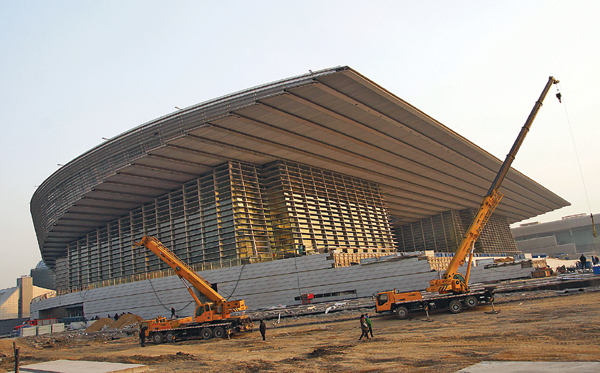
 |
|
Tianjin Grand theater is scheduled to open in May. Photo by Li Shengli/For China Daily |
Chinese cities often have place names in common. In many cities, you can find a "Drum Tower", "People's Park" or "Sun Yat-sen Road".
A new item on the list is "grand theater", which appears to have become a necessity for cities to show their competence. All major Chinese cities either have built, or are building, their grand theaters.
The Tianjin Grand Theater, which costs 1.5 billion yuan ($240 million), will open in May. Meanwhile, Nanjing, capital of Jiangsu province, will start building the Jiangsu Grand Theater in 2012, with an estimated budget of 2 billion yuan.
The most famous theater complexes in China are the National Center for the Performing Arts in Beijing, designed by French architect Paul Andreu and costing 3.2 billion yuan; Shanghai Grand Theater, designed by French architect Jean-Marie Charpentier and costing 1.2 billion yuan; and Guangzhou Opera House, designed by British architect Zaha Hadid, costing 1.38 billion yuan.
Though they have different English names, these theater complexes are all called dajuyuan (grand theater) in Chinese, and they have set examples for other cities to follow.
China's craze for grand theaters has persisted since the late 1990s and is showing no signs of a slowdown. The Pearl River Delta and Yangtze River Delta, two of the country's most developed areas, have the largest concentration. Apart from the mega-cities, smaller cities like Guangdong province's Zhongshan and Dongguan, and Jiangsu province's Wuxi and Changzhou have all built grand theaters in recent years.
Other areas are also catching up. In Shandong province, where the 10th China Arts Festival will be held in 2013, a batch of grand theaters are being built for the festival, including Ji'nan Grand Theater, Dezhou Grand Theater and Linyi Grand Theater, all of which cost hundreds of millions of yuan.

Feng Jicai, vice-president of the China Federation of Literary and Art Circles, criticizes the phenomenon as part of what he calls the "great leap forward in culture" being carried out by governments throughout China.
It's true that culture can't be built overnight, but money spent on cultural facilities is, after all, better than cash blown on, say, official banquets, which cost 300 billion yuan a year nationally, the Jiu San Society reports.
When the Berlin Philharmonic Orchestra toured Beijing for the first time in 1979, they could find nowhere to play except the Capital Gymnasium, which functioned better for sports than for symphony music.
In the 1980s and 1990s, many orchestras and ballet troupes performed at Great Hall of the People, a hall built for the purpose of political conferences, where acoustics rely on amplification.
When the National Center for the Performing Arts opened in December 2007, it immediately became the top venue for performing arts and the focus of citizens' attention. For several months, it was difficult to get a ticket to any performance held there, and big companies and organizations would buy out a whole performance for employees.
No doubt many people went mainly to see the architecture rather than the performances. Tourists would pay 30 yuan to tour the center in the daytime, and on the annual public open day, people would swarm the venue to have a look for free.
More than four years after its inauguration, the novelty value of the center is fading. The center is still filled with tourists every day, but there is a substantial regular audience who goes to see performances with friends or take their children to attend lectures on weekends.
Like the National Center for the Performing Arts, Shanghai Grand Theater has also become a center of citizens' cultural lives. Both play important cultural roles because they not only provide venues for art events but also produce their own shows and educational programs.
In China, the priority of Beijing and Shanghai over other areas is probably more obvious in terms of culture than the economy. These two cities have the most performing arts resources and are on the itineraries of most visiting international artists. The performances Beijing offers in one week are often more than what you can find in a provincial capital city in one month or in a third- or fourth-tier city in one year.
For both domestic and international performing groups, in the past, touring was often impractical because of the long distances and scarcity of proper venues in a vast country.
Now, with new theaters popping up everywhere and looking for projects, touring has become easier. The Chinese drama Rhinoceros in Love, which has been staged more than 900 times and has been very profitable, owes its success largely to the birth of new theaters around the country.
The building of new theaters across China also creates opportunities for provincial residents to share the prosperous cultural lives enjoyed by Beijingers and Shanghainese.
In healthy circumstances, theaters and promoters engaged in positive interactions with artists and help them produce more outstanding works.
But not every grand theater is doing this job. In some cities, local governments have built brand new theaters without knowing how to run them. Many of the grand theaters in smaller cities only occasionally put on government-sponsored events. For the rest of the year, they simply keep their doors shut.
Chinese artists are able to create first-class works, but without professional theaters and promoters, their works won't reach audiences. What China acutely lacks is not only advanced theaters but also management and programming personnel.
The good news is that the Yujiapu Arts Center, scheduled to open in 2015 in the Binhai New Area of Tianjin, has made agreements with the Lincoln Center, which will provide professional consulting in design, construction, programming, operation and employee training.
Hopefully, the knowledge of how to run theaters will be as respected as the buildings themselves. When China has not only world-class venues but also expertise in management and programming, great works will follow.